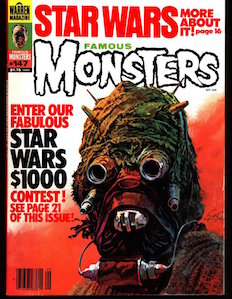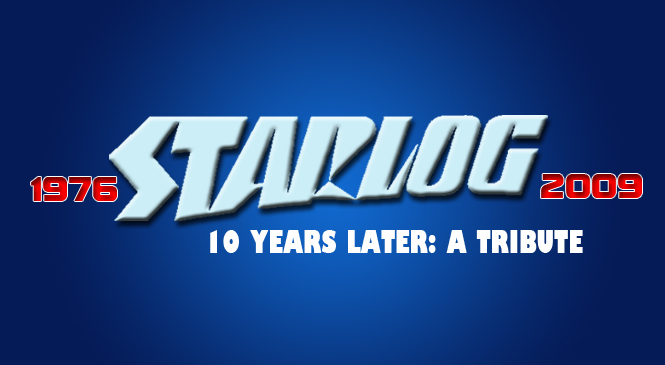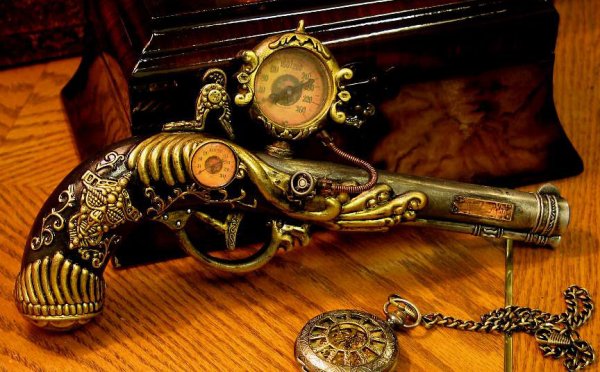Tony Timpone: From STARLOG to FANGORIA – Part One

Tony Timpone – the editor of Fangoria from 1986 to 2010, and a consultant and writer for the revived print version of the famous horror magazine – can remember the first time he saw Starlog.
 “I grew up reading Famous Monsters of Filmland – that was my go-to magazine as a kid – and I read comic books and things like that. And then Starlog came along in 1976 and I remember seeing it on the newsstand, and I saw this glossy magazine with color pages and an ad for a new KISS album on the back cover. And I was kind of like, I put it down in disgust because of course you know it blew away anything that Famous Monsters was doing in terms of presentation. It was for mature readers, it had color. Part of me realized, though, that this was the next generation of genre magazine, and then part of me also felt bad because I realize this is probably going to be the death knell for Famous Monsters. You know magazines like this aren’t going to cut it anymore.”
“I grew up reading Famous Monsters of Filmland – that was my go-to magazine as a kid – and I read comic books and things like that. And then Starlog came along in 1976 and I remember seeing it on the newsstand, and I saw this glossy magazine with color pages and an ad for a new KISS album on the back cover. And I was kind of like, I put it down in disgust because of course you know it blew away anything that Famous Monsters was doing in terms of presentation. It was for mature readers, it had color. Part of me realized, though, that this was the next generation of genre magazine, and then part of me also felt bad because I realize this is probably going to be the death knell for Famous Monsters. You know magazines like this aren’t going to cut it anymore.”
“I didn’t actually buy a copy of Starlog till I think issue 3, and I was more of a horror guy too. I love science fiction and fantasy, but my passion was really for horror. But I started buying Starlog religiously because I was into Star Trek and Star Wars, and I loved the retrospectives they did on older films and their episode guides to Twilight Zone. I’d gobble that up because there was no Internet then, there was no real access to that kind of information. Then the ads started appearing for this new magazine Fantastica, which of course became Fangoria. And I realized, wow, now we’re talking, now this is a magazine really for me.”
Those ads first appeared in 1978, but Timpone and everyone else who wanted to see Fantastica – then planned to be more focused on fantasy than the horror magazine it would become – would have to wait until July 31st, 1979. There was already a magazine on the stands called Fantastic Films, and their publisher sued over the name, arguing that the titles were too similar.
 “They thought that was a copyright infringement. So they had to change the name to Fangoria, and it came out and I fell in love with it.”
“They thought that was a copyright infringement. So they had to change the name to Fangoria, and it came out and I fell in love with it.”
Unfortunately, while Timpone certainly wasn’t alone in loving the new magazine, with its premiere issue boasting an interview with Christopher Lee and featuring Godzilla, sales… were not good. It quickly became clear that the title was losing money to the tune of around $20,000 each issue. Something had to change, or Fangoria just wasn’t going to make it. As it happened, it turned out to be two somethings.
First, an article about Tom Savini’s work on Dawn of the Dead had been a hit with the readers that they did have. While Savini was already being recognized for his makeup and effects work, the 1978 George Romero zombie classic essentially made him a star in the eyes of horror fans. He would, of course, become one of the icons of the horror world, creating the look of horror for decades with his work on films like Friday the 13th, Creepshow, Day of the Dead and many, many more.
The second thing that would change both the fortunes of Fangoria and the future of Tony Timpone was the sense that there simply wasn’t anything to lose by trying something new. Robert “Bob” Martin, Fangoria‘s first editor, took that fan reaction to the Savini article and ran with it, shifting the magazine’s focus to horror completely. It was a decision that saved Fangoria.
It also somewhat complicated Timpone’s initial attempts to write for the magazines he loved.
“When I was in high school I was doing a fanzine – I was the president of a science fiction club in high school, which was my first journalistic experience – and I would fantasize about writing for Famous Monsters or Fangoria someday. I’d go to a lot of the Star Trek and science fiction conventions in the late 70s, and I’d meet all these science fiction and horror people. And the first celebrity I met who I interviewed was Tom Savini. This was like, ’78 probably. And I interviewed him and I thought I could sell the interview to Famous Monsters, and they wrote me back ‘Oh this is a really good interview, but Tom Savini has been overexposed in Fangoria. So I ended up publishing my Savini interview in my high school fanzine.”
In the late 70’s and early 80’s, the convention scene was quite different than the giant media events that are the modern WonderCon, San Diego Comic-Con, and Wizard World shows. Where today’s conventions boast attendees in the tens of thousands, back then you were more likely to see crowds in the hundreds to the low thousands. They were also actually comic book focused conventions, with the move to incorporate gaming, films, TV, and hours-long celebrity photograph signing lines really only taking hold in the late 80’s. (Interestingly, about that time a certain Tim Burton film came out, starring the well-known comedic actor Michael Keaton.) In the mid-80’s, Creation Entertainment began producing Doctor Who conventions and other conventions that focused more on science fiction and horror, including the Weekend of Horrors, which they produced with Fangoria until 2009. Of course, smaller sizes and less media-focused cons didn’t mean that actors and filmmakers weren’t guests at the conventions then, because they certainly were. What it did mean, especially for someone like Timpone, was that you could actually talk to them.
“Once I got into college, I was meeting these Star Trek actors and Star Wars actors at the Creation science fiction conventions, and back then they were very approachable. You know, you call the hotel room of like, say, Anthony Daniels who played C-3PO, and I’d say ‘Oh I’d love to interview you for a magazine’ and they’d say ‘Sure, meet me in the coffee shop in 15 minutes.’ So I would interview these people, and eventually I broke into a magazine called Access Movieland, which was a really cheap Starlog knockoff. They published my Anthony Daniels interview, and after that I got noticed by Starlog. I started selling them some of these interviews while I was in college. I interviewed Merritt Butrick, who played Captain Kirk’s son in Star Trek II and III, and Starlog bought it, and that was my first published article in Starlog.”
Getting published in Starlog was great, but Timpone had his eyes on something else.
“My real dream was to write for Fangoria, but back then – in those early days between 1979 and 1984 – the magazine was edited by Bob Martin and Dave Everitt, and they did the majority of the articles themselves. They had this very unusual arrangement with the publisher Norman Jacobs, where they would be paid to both write and edit the magazine. So each of them would do four articles per issue, as well as edit the whole magazine, so you couldn’t really break into Fangoria, though I tried. I had an interview with the Coen Brothers for example, on Blood Simple, and I was hoping they would want it, but Bob had done that himself.”
Timpone kept writing, and found work, a mentor and a friend in Forrest J. Ackerman and his Monsterland magazine. A giant in the field, Ackerman co-created Famous Monsters of Filmland in 1958, and been a literary agent to some of the most influential writers in science fiction, including Ray Bradbury and Isaac Asimov. An avid collector of genre memorabilia, Ackerman was instrumental in both encouraging the growth of science fiction fandom and promoting science fiction as an actual genre that reached across all forms of media. When problems at Warren Publishing led to Famous Monsters‘ untimely end in 1983, New Media Publishing offered him the editor post at what began as Forrest J Ackerman’s MONSTER LAND. The magazine itself wouldn’t last more than a few years, but they were the right years for Timpone, keeping his writing out in the world while he was in college.
And meanwhile, the Starlog team knew who Timpone was, that he could write, and that he wanted to write for Fangoria.
“So I graduated from NYU with a journalism degree, and a few weeks out of school I got a call from Starlog: ‘Hey we’ve got a position opening up, come on in.’ I couldn’t believe how lucky I was and it was for an editorial job. So what I was going to be doing is – I got the job is what I should say – and originally what I was going to be doing was working on a whole bunch of titles for the Starlog group, which was not only publishing Starlog, but they had a bunch of teen magazines, Fangoria, wrestling, you name it. They had a huge stable of titles and I was going to be working on teen books and wrestling, and really stuff that I had no interest in, but I would be proofreading Starlog. But just around the time I started, or rather the week before I started, the co-editor of Fangoria Bob Martin quit to go work on the company’s music magazine, Hard Rock Video. And the other editor Dave Everitt had nobody to do the magazine with. So that Monday they said, ‘Tony you’re taking Bob Martin’s desk, so you’re going to be working with Dave now’, which is, you know, an embarrassment of riches. That was like a dream come true. I got lucky that Bob had left, and I was in the right place at the right time, and Dave took a liking to me right away. I went from captioning photos to writing articles for the magazine, and I was off and running the summer of 1985.”
Next in Part 2 of Tony Timpone: From Starlog to Fangoria:

![]()



